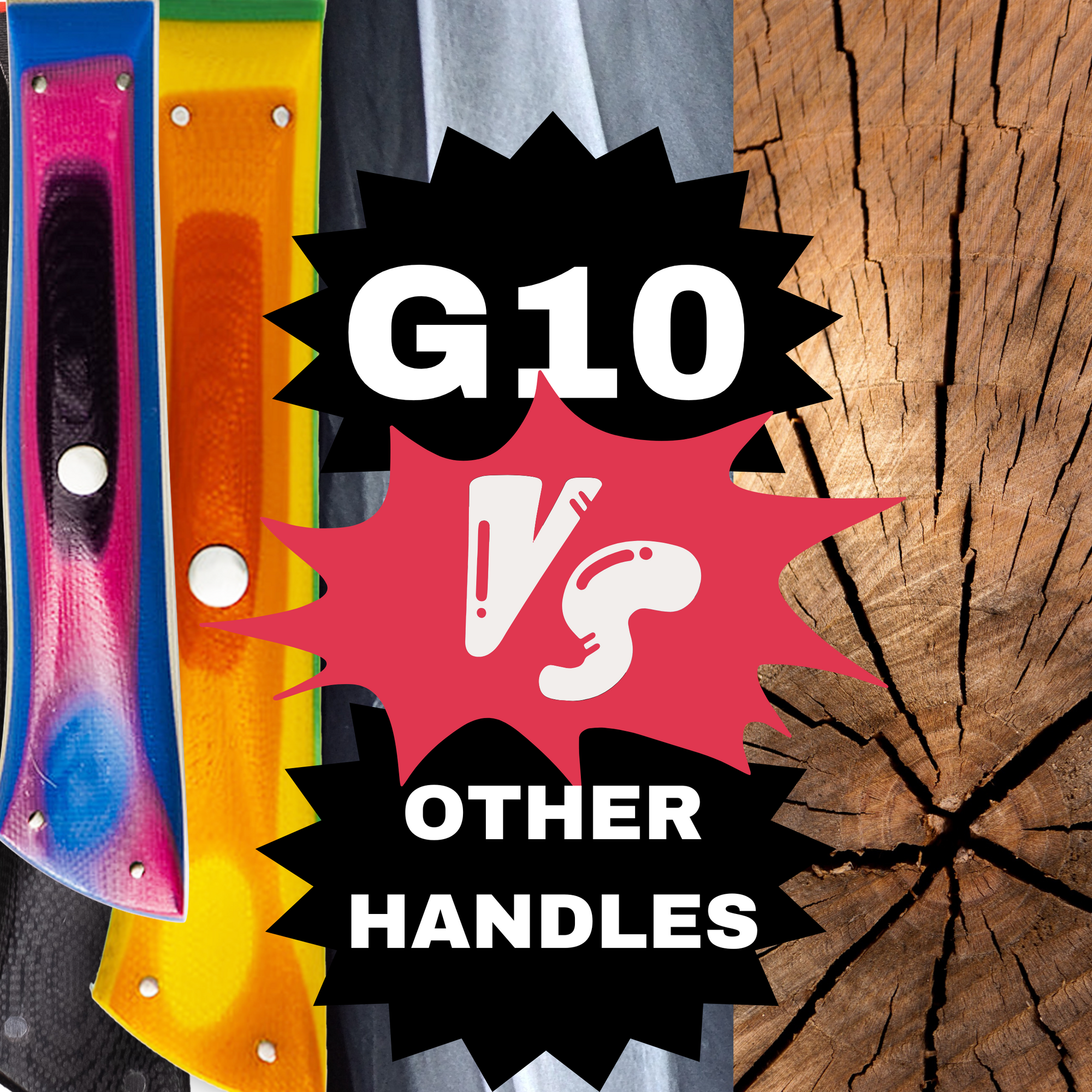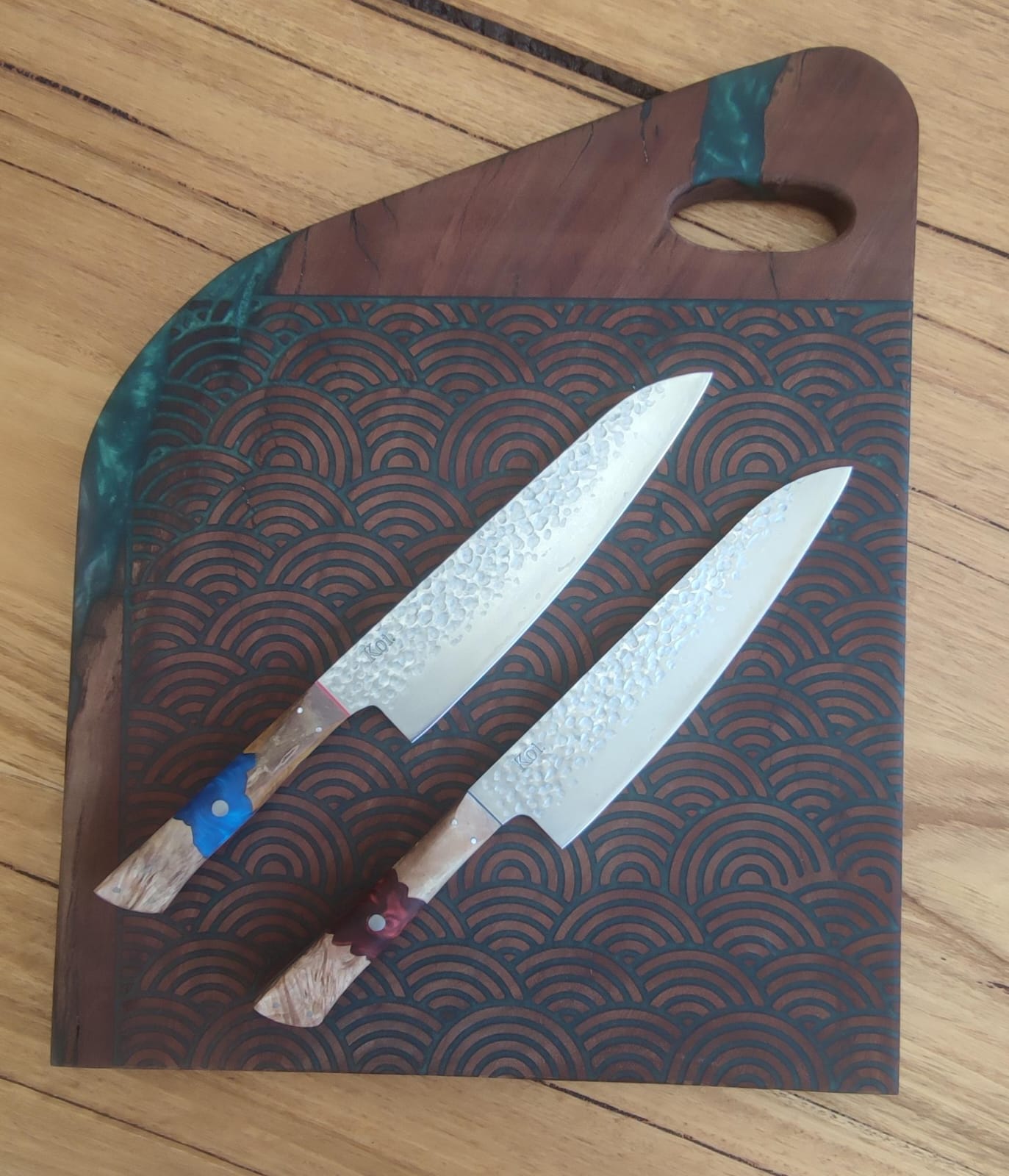G10 is a composite material that is commonly used to make knife handles. It comprises layers of fiberglass cloth impregnated with epoxy resin and then compressed and baked.
G10 is a popular handle material due to its durability, resistance to moisture, and ease of maintenance.
In this blog post, we will compare G10 to other common handle materials such as wood, bone, and carbon fibre and examine the advantages and disadvantages of each material.
Want to see some G10 handles in action?
Click here to check out our kitchen range of blades with G10 handles.
After something more portable? Check out the Koi Pocket knife range!
G10 Handle Material
G10 is a composite material made from layers of fiberglass cloth and resin pressed together under high pressure and temperature. The resulting material is strong, durable, and lightweight.
Advantages of G10
One of the main advantages of the G10 is its durability. It is resistant to impact, abrasion, and moisture, making it a popular choice for outdoor and tactical knives. Additionally, G10 is water-resistant, meaning it won't warp or rot over time.
Another advantage of G10 is its low maintenance. It requires little to no upkeep and can easily be cleaned with soap and water. Additionally, G10 is resistant to chemicals and solvents, making it suitable for harsh environments.
Disadvantages of G10
While G10 offers many benefits, it does have some drawbacks. One disadvantage is that it can be slippery when wet, making it difficult to grip. Additionally, some people find that G10 feels plasticky, which may not be as appealing as other materials like wood or bone.
Overall, G10 is a popular handle material due to its durability, low maintenance, and resistance to moisture and chemicals. However, it may not be the best choice for people prioritizing grip and feel over other qualities.
Wood Handle Material
Wood handle materials are popular for knife enthusiasts due to their classic and natural look. Wood comprises cellulose fibres held together by lignin, giving it unique properties. Some advantages of wood as a handle material include its aesthetic appeal, comfortable grip, and good shock absorption.
However, wood is not without its disadvantages. Wood can be prone to swelling and cracking, especially if exposed to moisture.
Additionally, wood requires regular maintenance, such as oiling or waxing, to keep it looking its best and to prevent cracking or splitting.
When choosing a handle material, wood can be an excellent option for those who prioritize aesthetics and comfort.
However, it may not be the best choice for those who need a more durable and low-maintenance option.
Bone Handle Material
Bone has been used as a handle material for knives for centuries, and it remains a popular choice among knife enthusiasts today. It's a natural material that provides a unique and rustic look that some people find aesthetically pleasing.
In terms of durability, bone is a sturdy material that can withstand regular use without showing much wear and tear. It also has a good grip, especially useful for knives used in wet or slippery conditions.
However, there are some downsides to using bone as a handle material. One of the major issues is that it can be heavy, which may make the knife less comfortable to use over extended periods. Additionally, bone is a porous material that can absorb moisture and oils, leading to staining if not properly cared for.
Overall, bone is a reliable and attractive handle material that can add a touch of natural beauty to a knife. However, it may not be the best choice for everyone, depending on personal preferences and the knife's intended use.
Carbon Fibre Handle Material
Carbon fibre is a handle material gaining popularity in the knife industry due to its unique properties. Carbon fibre comprises tightly woven carbon strands bound together with a resin. This material has several advantages, making it an excellent choice for knife handles.
The first advantage of carbon fibre is its lightweight nature. Carbon fibre is much lighter than other handle materials like wood or bone, making the knife easy to carry and handle for extended periods.
Additionally, carbon fibre is incredibly durable, making it ideal for knives that will be used in demanding environments. It is resistant to impact and scratches and will hold up well against wear and tear.
However, carbon fibre does have some disadvantages. One is that it is an expensive material, which can make knives made with it more costly. Additionally, carbon fibre can be slippery when wet, so it may not be the best choice for knives that will be used in wet or damp conditions.
Finally, carbon fibre is an attractive material. It has a sleek, modern look that many people find appealing.
Comparison of Handle Materials
When choosing a handle material, there are several factors to consider. Let's take a look at how G10, wood, bone, and carbon fibre compare in terms of their advantages and disadvantages:
|
Handle Material |
Advantages |
Disadvantages |
|
G10 |
Durable, lightweight, water-resistant, and easy to maintain |
Can feel somewhat plasticky and less aesthetically pleasing than natural materials. |
|
Wood |
Attractive, warm to the touch, and provides excellent grip |
Susceptible to water damage, warping, and cracking over time |
|
Bone |
Unique and visually striking, provides excellent grip, and can be polished to a high shine |
Less durable than synthetic or natural materials, can be porous and may require more maintenance |
|
Carbon Fibre |
Extremely lightweight, strong, and durable, with a sleek and modern look |
More expensive than other materials, can feel somewhat impersonal or lacking in character |
When choosing a handle material, it's important to consider the knife's intended use, the user's preferences, and any practical concerns such as maintenance and cost.
Ultimately, the best handle material is the one that meets your specific needs and preferences.
Conclusion
G10 offers several advantages over other handle materials, including its high strength-to-weight ratio, durability, and resistance to moisture and chemicals.
Its superior grip and control properties also make it an excellent choice for knives used in demanding conditions.
Although it may be more expensive than other handle materials, the benefits of G10 make it a worthwhile investment for anyone in need of a high-performance knife.




